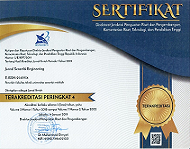Analisis Kandungan Fosfat dan Variabilitas Laju Aliran Udara pada Pembentukan Struvite dari Air Limbah Pupuk
Keywords:
fertilizer wastewater, recovery, phosphate, magnesium, struviteAbstract
Phosphate and Ammonia rich fertilizer wastes pose potential environmental problems. Depletion of natural phosphate sources encourages the search for sustainable alternatives. This study examined phosphate recovery from fertilizer plant effluent using struvite (MgNH4PO4-6H2O) in a batch vertical reactor. The factors studied were pH, temperature, air flow rate, and solution molar ratio. Struvite is formed by reacting Mg2+, NH4+, and PO43-ions. This study used MgCl2 : waste molar ratios of 2:1, 2.5:1, and 3:1, air flow rates of 0.25, 0.50, 0.75, and 1.00 L/min, and pH of 8, 9, 10, and 11. The MAP solution with the specified molar ratio was introduced into the reactor up to 3⁄4 of its volume. The air flow rate and pH were set according to the parameters. The MAP solution was collected and filtered to produce struvite. Struvite crystals were analyzed by XRF and SEM. Results showed the best phosphate recovery of 67.3% at a ratio of 2.5:1, air flow rate of 1.00 L/min, and pH of 10. This study demonstrates the potential of struvite as a sustainable phosphate recovery solution from fertilizer waste
















